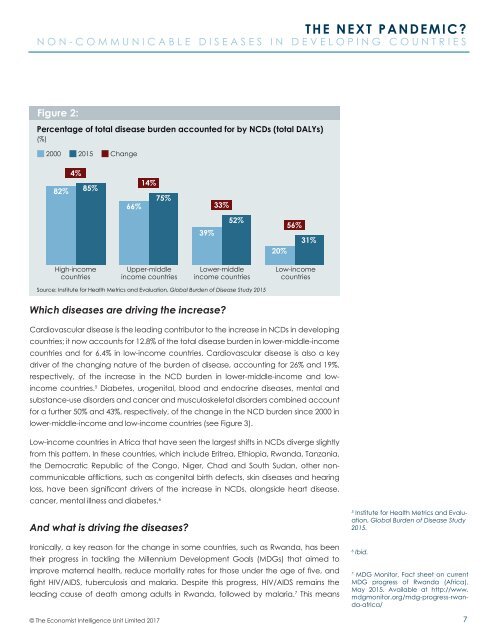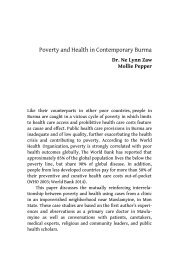THE NEXT PANDEMIC?
Thenextpandemic
Thenextpandemic
You also want an ePaper? Increase the reach of your titles
YUMPU automatically turns print PDFs into web optimized ePapers that Google loves.
<strong>THE</strong> <strong>NEXT</strong> <strong>PANDEMIC</strong>?<br />
NON-COMMUNICABLE DISEASES IN DEVELOPING COUNTRIES<br />
Figure 2:<br />
Percentage of total disease burden accounted for by NCDs (total DALYs)<br />
(%)<br />
2000 2015 Change<br />
82%<br />
4%<br />
85%<br />
66%<br />
14%<br />
75%<br />
33%<br />
39%<br />
52%<br />
20%<br />
56%<br />
31%<br />
High-income<br />
countries<br />
Upper-middle<br />
income countries<br />
Lower-middle<br />
income countries<br />
Low-income<br />
countries<br />
Source: Institute for Health Metrics and Evaluation, Global Burden of Disease Study 2015<br />
Which diseases are driving the increase?<br />
Cardiovascular disease is the leading contributor to the increase in NCDs in developing<br />
countries; it now accounts for 12.8% of the total disease burden in lower-middle-income<br />
countries and for 6.4% in low-income countries. Cardiovascular disease is also a key<br />
driver of the changing nature of the burden of disease, accounting for 26% and 19%,<br />
respectively, of the increase in the NCD burden in lower-middle-income and lowincome<br />
countries. 5 Diabetes, urogenital, blood and endocrine diseases, mental and<br />
substance-use disorders and cancer and musculoskeletal disorders combined account<br />
for a further 50% and 43%, respectively, of the change in the NCD burden since 2000 in<br />
lower-middle-income and low-income countries (see Figure 3).<br />
Low-income countries in Africa that have seen the largest shifts in NCDs diverge slightly<br />
from this pattern. In these countries, which include Eritrea, Ethiopia, Rwanda, Tanzania,<br />
the Democratic Republic of the Congo, Niger, Chad and South Sudan, other noncommunicable<br />
afflictions, such as congenital birth defects, skin diseases and hearing<br />
loss, have been significant drivers of the increase in NCDs, alongside heart disease,<br />
cancer, mental illness and diabetes. 6<br />
And what is driving the diseases?<br />
Ironically, a key reason for the change in some countries, such as Rwanda, has been<br />
their progress in tackling the Millennium Development Goals (MDGs) that aimed to<br />
improve maternal health, reduce mortality rates for those under the age of five, and<br />
fight HIV/AIDS, tuberculosis and malaria. Despite this progress, HIV/AIDS remains the<br />
leading cause of death among adults in Rwanda, followed by malaria. 7 This means<br />
© The Economist Intelligence Unit Limited 2017<br />
5<br />
Institute for Health Metrics and Evaluation,<br />
Global Burden of Disease Study<br />
2015.<br />
6<br />
Ibid.<br />
7<br />
MDG Monitor, Fact sheet on current<br />
MDG progress of Rwanda (Africa),<br />
May 2015. Available at http://www.<br />
mdgmonitor.org/mdg-progress-rwanda-africa/<br />
7








